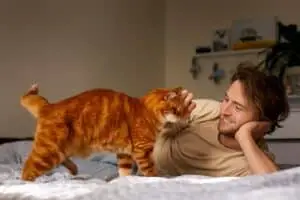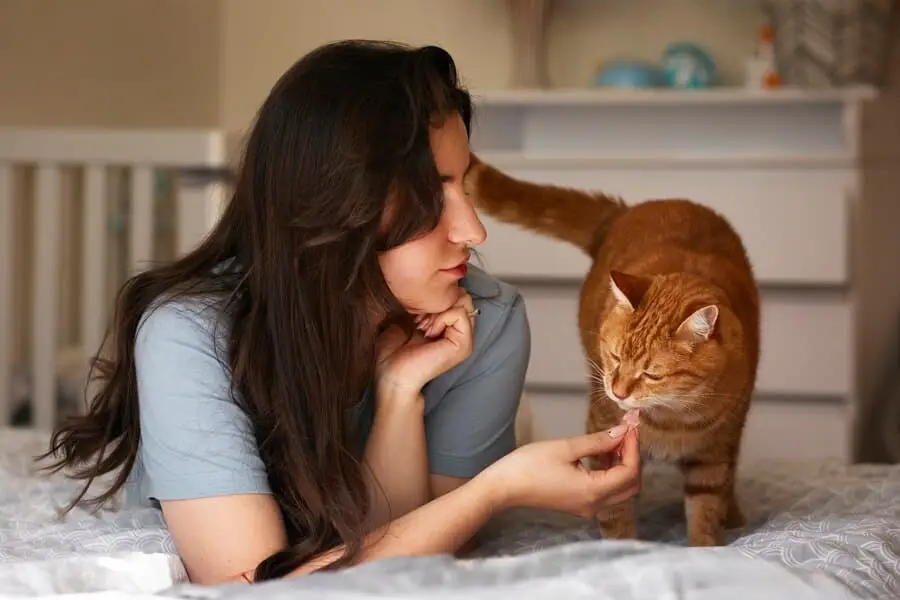

Cats are fascinating creatures with a wide array of behaviors that can puzzle even the most experienced pet owners. Understanding why cats act a certain way can strengthen the bond between you and your feline friend. Below are some common cat behaviors and their possible explanations:
Kneading: Have you ever been lounging on your couch when your feline friend starts rhythmically pressing their paws into a plush blanket or even your lap. This charming behavior is known as kneading and it’s something almost every cat owner has experienced. Kneading is one of the many ways cats express their comfort and affection.
So next time your kitty starts their delightful paw dance on your blanket or lap, take a moment to enjoy this endearing display of feline charm.
Head-Butting: Ever Wondered why your cat gently bumps its head against you? This behavior, Known as head-butting or head butting- it’s a significant form of feline communication filled with meaning and affection.
Purring: One of the most delightful cat behaviors, purring often indicates happiness and relaxation. However cats may also purr when they are in pain or feeling anxious, as the vibrations can be self-soothing.
Bringing Gifts: A less pleasant but quite typical behavior is when cats bring dead or partially alive prey to their owners. This is a natural hunting instinct and a way for your cat to share its success with you.
Tail Language: Cats have an intricate way of communicating, and one of their most expressive tools is their tail. Understanding cat tail language can help you get to know your feline friend better and respond to their needs. A high, upright tail usually signals a happy cat, while a puffed-up tail indicates fear or aggression. A twitching tail can signify irritation.
Ever noticed other tail behaviors in your cat? Share your observations and let us decode more feline mysteries together.
Scratching: Scratching serves several purposes; marking territory, sharpening claws and scratching. Providing scratching posts can satisfy this need and save your furniture.
Hiding: Cats often hide when they are stressed, scared or not feeling well. If your cat suddenly starts hiding more than usual, it might be worth consulting a vet.
Meowing: Cats rarely meow at other cats; the behavior is reserved for humans. Your Cat is trying to communicate something specific, whether it’s wanting food, attention, or even expressing discomfort.
Belly Exposure: When a cat exposes its belly, it signifies a high level of trust, as their most vulnerable area. In the wild, a cat’s belly is where vital organs are located, making it a critical area to protect. By Showing you their belly, your cat is indicating that they feel safe in your presence and don’t perceive you as a threat. However, this trusting gesture is a bit of a double-edged sword. While it’s adorable and heartwarming to see, it doesn’t necessarily mean your cat wants belly rubs. In fact. Many cats have a strong instinct to protect their stomach, even around trusted humans.
Think of it as a human handing you their most prized possession- not necessarily an invitation to use it, but a sign of deep trust.
Slow Blinking: Ever caught your cat giving you a slow, deliberate blink? It might just be the feline equivalent of a warm hug! When your cat slowly blinks at you, try slow-blinking back. Its exchange is so powerful that it’s often called a “cat kiss”. It’s their way of saying “ I love You” without uttering a word. So next time your feline friend gives you that slow, trusting blink, remember, you are not just a pet owner- You are part of their family. Try blinking back and revel in the special bond you share. After all, love sometimes needs no word, Just a simple blink.
Understanding the reasons behind a cat’s behavior can significantly enhance your relationship with your feline companion. Each cat possesses unique characteristics, such that careful observation and learning about their individual traits are essential for developing a harmonious bond.
@ 2024 My 2 Dogs UK Ltd. Company Number 15622192 All Rights Reserved